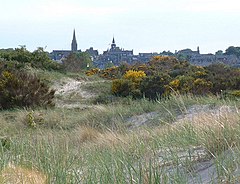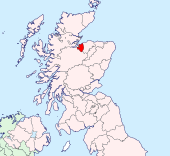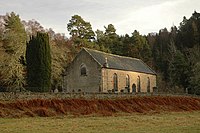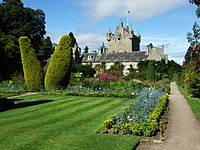Nairnshire: Difference between revisions
No edit summary |
mNo edit summary |
||
| (16 intermediate revisions by 2 users not shown) | |||
| Line 1: | Line 1: | ||
{{Infobox county | {{Infobox county | ||
|name=Nairnshire | |name=Nairnshire | ||
|map image= | |map image=Nairnshire Brit Isles Sect 2.svg | ||
|picture=Nairn - geograph.org.uk - 185203.jpg | |picture=Nairn - geograph.org.uk - 185203.jpg | ||
|picture caption=Nairn | |picture caption=Nairn | ||
|county town=[[Nairn]] | |county town=[[Nairn]] | ||
}} | }} | ||
The '''County of Nairn''' is a small [[Counties of the United Kingdom|shire]] at the head of the [[Moray Firth]]. | The '''County of Nairn''' is a small [[Counties of the United Kingdom|shire]] at the head of the [[Moray Firth]]. It is bounded on the west and south by [[Inverness-shire]] and on the east by [[Morayshire]]. The county's northern edge is on the sea, its coast washed by the Moray Firth. It has an area of just 200 square miles and a coastline of nine miles long. Only four counties are smaller: [[Clackmannanshire]], [[Kinross-shire]], [[West Lothian]] and [[Rutland]]. | ||
{{ | There are five detached parts: | ||
Det 1: An area on the east bank of the [[River Findhorn]] in the north-east of the parish of [[Dyke and Moy]] in Morayshire. | |||
Det 2 & 3: Locally situate in parish of [[Edinkillie]], Morayshire, these also form detached parts of the ancient parish of [[Ardclach]]. | |||
Det 4: Locally situate in the southern part of the parish of [[Daviot and Dunlichity]], Inverness-shire. | |||
Det 5: The barony of Ferintosh in the parish [[Urquhart and Logie Wester]], [[Ross-shire]]. | |||
==Geography== | |||
===Landscape=== | |||
The seaboard is skirted by sandbanks dangerous to navigation, but the beaches are charming, lined by low dunes extending into Morayshire. Parallel with the coast there is a deposit of sand and gravel stretching inland for up to five miles: this and the undulating plain behind are a continuation westward of the fertile Laigh of Moray. | |||
Nairnshire's landscape rises only in the south, up to the border of Inverness-shire. Several of these border hills of Nairnshire exceed 2,000 feet above sea level, the highest being [[Carn Glas-choire|Carn Glas]], the [[county top]] at 2,162 feet. | |||
The only sizeable rivers of the county are the [[River Findhorn|Findhorn]] and the [[River Nairn|Nairn]], both of which rise in Inverness-shire. The Findhorn flows mainly north-eastwards down Strathdearn for 17 miles. and drowns in the sea to the north of [[Forres]] in Morayshire after a total course of 70 miles. The Nairn, shortly after issuing from Strathnairn, flows towards the north-east for 12 miles out of its complete course of 38 miles and enters the Moray Firth at the county town, Nairn. | |||
There are eight lochs in the county, all small. The Loch of Clans is of particular interest because of its examples of crannogs, or lake-dwellings. | |||
Nairnshire contains many beautiful woods and much picturesque and romantic scenery. | |||
===Geology=== | |||
The county is divided geologically into two clearly-marked portions; the north and the south. | |||
The southern and larger portion is composed of the eastern, Dalradian or younger Highland schists with associated granite masses; this forms all the higher ground. | |||
The low-lying northern part of the county bordering the Moray Firth is occupied by old red sandstone. The schistose rocks are mainly thin bedded micaceous gneisses, schists and quartzites; between Dallaschyle and Creag an Dairnb a more massive higher horizon appears in the centre of a synclinal fold. Porphyritic gneiss is found on the flanks of Caen nan tri-tighearnan. The schists are frequently intersected by dikes of granite and amphibolite. | |||
Three masses of granite are found penetrating the schists; the largest lies on the eastern boundary and extends from about Lethca Bar Hill southward by [[Ardclach]] and [[Glenferness]] to the Bridge of Dulsie. The second mass on the opposite side of the county belongs mainly to Inverness-shire but the granite reaches into Nairn on the slopes of Bein nan Creagan and Ben Buidhe Mhor. A smaller mass found near Rait Castle with large pink crystals of orthoclase, has been employed as a building stone but on the denuded surface of the schists the old red sandstone was deposited and formerly doubtless covered most of the county as outlying patches still remain near Drynachan Lodge and near Highland Boath in Muckle Burn. | |||
==History== | |||
Whether there was any effective Roman occupation of the land so far north is an open question, the occasional finding of coins suggests that Romans knew this land. A possible Roman fort has been excavated at [[Cawdor]], which would be the northernmost Roman fort in Britain; it may date from the advance by Agricola (recounted heroically by Tacitus) which culminated in the defeat of the last native resistance under Calgarcus at the Battle of ''Mons Graupius'', whose site is unknown. Otherwise there is little evidence of a Roman presence in Nairnshire nor anywhere northward. | |||
Columba began the long process of bring Christ to the Picts. As the 10th century opened, the Norse had taken control of the land and Nairn was colonized by Scandinavians, forming part of the ancient province of Moray. Soon afterwards this became part of the kingdom of [[Scotland]]. | |||
According to Shakespeare (and before him Holinshed), Macbeth was Thane of [[Glamis]] in [[Angus]] and was made Thane of Cawdor in Nairnshire too. Historically he certainly ruled in Moray. Hardmuir, between [[Brodie]] and [[Nairn]], is the reputed heath where Macbeth met the three witches. The old province of Moray was shrunk by David I. The thane of Cawdor was constable of the king's castle at Nairn, and when the heritable sheriffdom was established towards the close of the 14th century this office, and the government of Nairnshire, was held by the thane. | |||
At the Union in 1707, Nairnshire was grouped with [[Cromartyshire]] to elect a member to Parliament alternately between them. | |||
During the Second World War, Nairn became a key link in the air defence chain: the Post Office repeater station by [[Auldearn]] was one of only two in the Highland area and linked north and south in the air defence communications chain. | |||
==Towns and parishes== | |||
[[File:Church at Ardclach - geograph.org.uk - 659845.jpg|right|thumb|200px|Ardclach]] | |||
There is but one town in Nairnshire: [[Nairn]], the county town. It is a town with blossomed as a Victorian resort before quietening down somewhat. Today though Nairn is undergoing growth unprecedented in its history as it lies just a few miles from [[Inverness]], the "Capital of the Highlands" and the growth of Inverness is drawing attention to Nairn also. | |||
Elsewhere the county has a scattering of pretty villages, some grown by the influence of the railway, but those farther from the line content in their relative isolation. | |||
The parishes of Nairnshire are: | |||
{{parishliststart}} | |||
*[[Ardclach]] | |||
*[[Auldearn]] | |||
*[[Cawdor]] | |||
*[[Nairn]] | |||
{{parishlistend}} | |||
Additionally some of the surrounding parishes lie partly in Nairnshire and partly in Inverness-shire: | |||
*Part of the parish of [[Croy and Dalcross]] falls within Nairnshire in two places: around [[Clephanton]] to the south-east of Nairn and [[Dalroy]] in the south-east of the county. | |||
*Two very small parts of the parish of [[Daviot and Dunlichity]] fall within Nairnshire to the east of Dalroy. | |||
*The protrusion of Nairnshire into Inverness-shire along the Old Military Road (Calder's Braichlich) is in the parish of [[Petty]]. | |||
==Sights of Nairnshire== | |||
{{UKPlacesKey}} | |||
[[File:Cawdor Castle2.jpg|left|thumb|200px|Cawdor Castle]] | |||
To the north of Dulsie Bridge is a monolith called the Princess Stone. A greater number of the mysterious prehistoric stones with cup-markings occur in Nairn than any-where else in the north. Mote hills are also common. Compared with these, the fine castles of the shire seem positively modern. | |||
*{{i-Castle}} [[Cawdor Castle]] | |||
*The Princess Stone | |||
{{British county}} | {{British county}} | ||
Latest revision as of 19:13, 5 January 2021
| Nairnshire United Kingdom | |
 Nairn | |
|---|---|
| Unite and be Mindful | |

| |
| [Interactive map] | |
| Area: | 200 square miles |
| Population: | 13,894 |
| County town: | Nairn |
| County flower: | Chickweed wintergreen [1] |
The County of Nairn is a small shire at the head of the Moray Firth. It is bounded on the west and south by Inverness-shire and on the east by Morayshire. The county's northern edge is on the sea, its coast washed by the Moray Firth. It has an area of just 200 square miles and a coastline of nine miles long. Only four counties are smaller: Clackmannanshire, Kinross-shire, West Lothian and Rutland.
There are five detached parts:
Det 1: An area on the east bank of the River Findhorn in the north-east of the parish of Dyke and Moy in Morayshire.
Det 2 & 3: Locally situate in parish of Edinkillie, Morayshire, these also form detached parts of the ancient parish of Ardclach.
Det 4: Locally situate in the southern part of the parish of Daviot and Dunlichity, Inverness-shire.
Det 5: The barony of Ferintosh in the parish Urquhart and Logie Wester, Ross-shire.
Geography
Landscape
The seaboard is skirted by sandbanks dangerous to navigation, but the beaches are charming, lined by low dunes extending into Morayshire. Parallel with the coast there is a deposit of sand and gravel stretching inland for up to five miles: this and the undulating plain behind are a continuation westward of the fertile Laigh of Moray.
Nairnshire's landscape rises only in the south, up to the border of Inverness-shire. Several of these border hills of Nairnshire exceed 2,000 feet above sea level, the highest being Carn Glas, the county top at 2,162 feet.
The only sizeable rivers of the county are the Findhorn and the Nairn, both of which rise in Inverness-shire. The Findhorn flows mainly north-eastwards down Strathdearn for 17 miles. and drowns in the sea to the north of Forres in Morayshire after a total course of 70 miles. The Nairn, shortly after issuing from Strathnairn, flows towards the north-east for 12 miles out of its complete course of 38 miles and enters the Moray Firth at the county town, Nairn.
There are eight lochs in the county, all small. The Loch of Clans is of particular interest because of its examples of crannogs, or lake-dwellings.
Nairnshire contains many beautiful woods and much picturesque and romantic scenery.
Geology
The county is divided geologically into two clearly-marked portions; the north and the south.
The southern and larger portion is composed of the eastern, Dalradian or younger Highland schists with associated granite masses; this forms all the higher ground.
The low-lying northern part of the county bordering the Moray Firth is occupied by old red sandstone. The schistose rocks are mainly thin bedded micaceous gneisses, schists and quartzites; between Dallaschyle and Creag an Dairnb a more massive higher horizon appears in the centre of a synclinal fold. Porphyritic gneiss is found on the flanks of Caen nan tri-tighearnan. The schists are frequently intersected by dikes of granite and amphibolite.
Three masses of granite are found penetrating the schists; the largest lies on the eastern boundary and extends from about Lethca Bar Hill southward by Ardclach and Glenferness to the Bridge of Dulsie. The second mass on the opposite side of the county belongs mainly to Inverness-shire but the granite reaches into Nairn on the slopes of Bein nan Creagan and Ben Buidhe Mhor. A smaller mass found near Rait Castle with large pink crystals of orthoclase, has been employed as a building stone but on the denuded surface of the schists the old red sandstone was deposited and formerly doubtless covered most of the county as outlying patches still remain near Drynachan Lodge and near Highland Boath in Muckle Burn.
History
Whether there was any effective Roman occupation of the land so far north is an open question, the occasional finding of coins suggests that Romans knew this land. A possible Roman fort has been excavated at Cawdor, which would be the northernmost Roman fort in Britain; it may date from the advance by Agricola (recounted heroically by Tacitus) which culminated in the defeat of the last native resistance under Calgarcus at the Battle of Mons Graupius, whose site is unknown. Otherwise there is little evidence of a Roman presence in Nairnshire nor anywhere northward.
Columba began the long process of bring Christ to the Picts. As the 10th century opened, the Norse had taken control of the land and Nairn was colonized by Scandinavians, forming part of the ancient province of Moray. Soon afterwards this became part of the kingdom of Scotland.
According to Shakespeare (and before him Holinshed), Macbeth was Thane of Glamis in Angus and was made Thane of Cawdor in Nairnshire too. Historically he certainly ruled in Moray. Hardmuir, between Brodie and Nairn, is the reputed heath where Macbeth met the three witches. The old province of Moray was shrunk by David I. The thane of Cawdor was constable of the king's castle at Nairn, and when the heritable sheriffdom was established towards the close of the 14th century this office, and the government of Nairnshire, was held by the thane.
At the Union in 1707, Nairnshire was grouped with Cromartyshire to elect a member to Parliament alternately between them.
During the Second World War, Nairn became a key link in the air defence chain: the Post Office repeater station by Auldearn was one of only two in the Highland area and linked north and south in the air defence communications chain.
Towns and parishes

There is but one town in Nairnshire: Nairn, the county town. It is a town with blossomed as a Victorian resort before quietening down somewhat. Today though Nairn is undergoing growth unprecedented in its history as it lies just a few miles from Inverness, the "Capital of the Highlands" and the growth of Inverness is drawing attention to Nairn also.
Elsewhere the county has a scattering of pretty villages, some grown by the influence of the railway, but those farther from the line content in their relative isolation.
The parishes of Nairnshire are:
Additionally some of the surrounding parishes lie partly in Nairnshire and partly in Inverness-shire:
- Part of the parish of Croy and Dalcross falls within Nairnshire in two places: around Clephanton to the south-east of Nairn and Dalroy in the south-east of the county.
- Two very small parts of the parish of Daviot and Dunlichity fall within Nairnshire to the east of Dalroy.
- The protrusion of Nairnshire into Inverness-shire along the Old Military Road (Calder's Braichlich) is in the parish of Petty.
Sights of Nairnshire
| Key | |
| Cathedral/Abbey/Priory | |
| Accessible open space | |
| Amusement/Theme Park | |
| Castle | |
| Country Park | |
| Historic Scotland | |
| Forestry Commission | |
| Heritage railway | |
| Historic House | |
| Museum (free/not free) | |
| National Trust for Scotland | |
| Zoo | |

To the north of Dulsie Bridge is a monolith called the Princess Stone. A greater number of the mysterious prehistoric stones with cup-markings occur in Nairn than any-where else in the north. Mote hills are also common. Compared with these, the fine castles of the shire seem positively modern.
 Cawdor Castle
Cawdor Castle- The Princess Stone
| Counties of the United Kingdom |
|---|
|
Aberdeen • Anglesey • Angus • Antrim • Argyll • Armagh • Ayr • Banff • Bedford • Berks • Berwick • Brecknock • Buckingham • Bute • Caernarfon • Caithness • Cambridge • Cardigan • Carmarthen • Chester • Clackmannan • Cornwall • Cromarty • Cumberland • Denbigh • Derby • Devon • Dorset • Down • Dumfries • Dunbarton • Durham • East Lothian • Essex • Fermanagh • Fife • Flint • Glamorgan • Gloucester • Hants • Hereford • Hertford • Huntingdon • Inverness • Kent • Kincardine • Kinross • Kirkcudbright • Lanark • Lancaster • Leicester • Lincoln • Londonderry • Merioneth • Middlesex • Midlothian • Monmouth • Montgomery • Moray • Nairn • Norfolk • Northampton • Northumberland • Nottingham • Orkney • Oxford • Peebles • Pembroke • Perth • Radnor • Renfrew • Ross • Roxburgh • Rutland • Selkirk • Shetland • Salop • Somerset • Stafford • Stirling • Suffolk • Surrey • Sussex • Sutherland • Tyrone • Warwick • West Lothian • Westmorland • Wigtown • Wilts • Worcester • York |